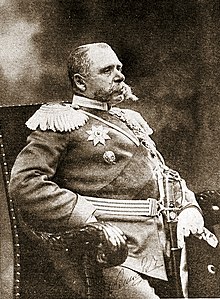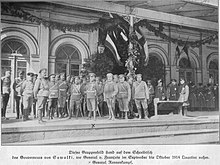Paul von Rennenkampff
Paul Georg Edler von Rennenkampff ( Russian Павел-Георг Карлович Ренненкампф transcribed Pawel-Georg Karlovich Rennenkampf ; born April 17, jul. / 29. April 1854 greg. On Konofer / ( Estonian Konuvere ), Russian-Estonia ; † 1. April 1918 in Taganrog , Russia ) was cavalry general of the Russian army and adjutant general of Tsar Nicholas II. In 1914 he led the offensive against East Prussia as commander-in-chief of the Nyemen army .
Life
Rennkampff was born into a German Baltic family. From 1866 to 1870 he attended the Knight and Cathedral School in Reval . After entering service in the 89th Belomorsk Infantry Regiment, he was sent to the Junker School in Helsingfors . After completing the course, he joined the 16th Gluchow Dragoon Regiment as a junker and immediately switched to the 14th Dragoon Regiment, then to the 5th Lithuanian Uhlan Regiment .
In 1873 he was promoted to cornet , in 1876 to lieutenant and in 1877 to staff assistant master. From 1879 he attended the General Staff Academy in Saint Petersburg , which he promoted to Rittmeister on April 1, 1882 , graduated as top of the class. Promoted to major on June 11, 1882 , he became a senior staff officer in the General Staff of the XIV Army Corps. He served in the military districts of Warsaw , Kazan , Novocherkassk and was promoted to lieutenant colonel on April 13, 1886 .
On March 26, 1890 he was briefly promoted to chief of staff of the fortress commander of Ossowiec and on April 1 of the same year to colonel . On February 26, 1891 he was appointed Chief of Staff of the 14th Cavalry Division in Kielce . On December 13, 1895 he took command of the 36th Akhtyrka Dragon Regiment and on November 25, 1899 he was appointed chief of staff of the Transbaikal area .
Appointed major general on April 9, 1900 , he distinguished himself as commander of an infantry regiment during the Boxer Uprising in China. Rennkampff's task was to secure the area on the Amur . He led General Gribkow, who was being harassed by the Chinese, to reinforce Manchuria and occupied Aigun . Then he took Zizikar and Girin and advanced through Telin to Mukden . For these services he was awarded the Order of St. George IV and III. Class excellent. In 1901 he refused command of a guard regiment and was then given command of the 1st Cavalry Brigade in Borissow.
From 1904 to 1905 he took part in the Russo-Japanese War . In February 1904 he took over the leadership of the 2nd Transbaikal Cossack Division, was seriously wounded on July 13 and promoted to lieutenant general on the same day . In January he covered with his cavalry the left wing of the units returning at Tzinketschan and represented the wounded General Mitschenko, who was deployed on the right wing. After the battle of Mukden he was accused of cowardice before the enemy on various occasions. At that time, Rennenkampff had fallen out with General Samsonow in a dispute at the Mukden train station . He rehabilitated himself when he and General Möller-Sakomelski fought the rebels of the revolution of 1905 in Siberia .
From November 9, 1905 to April 15, 1906 he was Commanding General of the 7th Siberian Army Corps. On July 9, 1906, he became the commanding general of the 3rd Siberian Army Corps in the Far East and then returned to Europe. From December 27, 1906 to January 20, 1913 he was Commanding General of the III. Army Corps in Vilnius . On December 6, 1910 he was promoted to general of the cavalry . From October 5, 1912, he served as adjutant general to His Majesty Nicholas II . From January 1913 until the beginning of the war in 1914 he was commander in chief of the military district of Vilnius.

At the beginning of the First World War , Rennenkampff was given command of the 1st Army on the Nyemen , which was destined to invade East Prussia on the northern section of the Eastern Front . On August 17th, his troops crossed the border at Stallupönen and drove back the German 8th Army in the battle of Gumbinnen . His behavior during the Battle of Tannenberg at the end of August 1914, in particular the lack of coordination with the Russian 2nd Army under General Samsonov , which resulted from the hostility of the commanders , led to harsh criticism from the Russian Army High Command and the Tsar . After another defeat in the Battle of the Masurian Lakes , they had to retreat to the Angerapp River . After his army had moved to the north of Warsaw , his troops were able to cut off an attack by the German 9th Army on Lodz between November 16 and 22 . The destruction of an encircled German corps on November 24th was no longer successful because its troops had withdrawn prematurely. Blamed by the commander in chief of the Northwestern Front, General Russki , he then lost command of the 1st Army. At the end of 1914 he resigned from the army after he was accused of incompetence and, due to his Baltic German origin, even treason . He retired completely from public life and moved to the Black Sea . In total, he served in the Russian army for over 40 years.
After the Russian Revolution in 1917 he was arrested and released. In 1918 he fled to Taganrog on the Sea of Azov , called himself Mandusakis and claimed to be a Greek fisherman. On March 16, his camouflage was blown and the Bolsheviks asked him to command a communist unit of the Red Army in the Russian civil war . He refused and Vladimir Alexandrovich Antonov-Ovsejenko then ordered his execution , which was carried out on April 1, 1918 by firing squad . The body was buried in the old Taganrog municipal cemetery .
The entire large estate of the von Rennkampff families, like all Baltic Germans, was expropriated in 1919 as part of the Estonian land reform . Rennkampff's personal effects from the time of the Boxer Rebellion are on display in the Alferaki Palace in Taganrog .
Fonts
- On the Amur River and in Manchuria , General P. v. R. von 1904, Part I, published in Wojennyj Sbornik, No. 3, pp. 89-108.
- On the Amur River and in Manchuria , Part II, published in Wojennyj Sbornik, No. 4, pp. 57–86.
- On the Amur River and in Manchuria , Part III, published in Wojennyj Sbornik, No. 5, pp. 55–86.
- The twenty-day battle of my detachment in the Battle of Mukden , Berlin, 1909.
literature
- Lutz von Rennenkampff: Genealogy of those von Rennenkampff. Cologne 2007, Volume V, p. 41. (online) ( Memento from October 23, 2013 in the Internet Archive )
Web links
- Baltic Historical Commission (ed.): Entry on Paul von Rennenkampff. In: BBLD - Baltic Biographical Lexicon digital
- Biography at Spartacus Schoolnet ( engl. )
- Biography at RussoJapaneseWar.com
- Genealogy of Paul von Rennenkampff (Kf.13) ( Memento from October 23, 2013 in the Internet Archive ) (PDF file; 3.68 MB)
- Genealogical Handbook of the Baltic Knighthoods, Görlitz 1930, Part Estonia, Volume III, p. 209.
- Military biography
- Article Paul von Rennenkampff in the Great Soviet Encyclopedia (BSE) , 3rd edition 1969–1978 (Russian)
- Newspaper article about Paul von Rennenkampff in the 20th century press kit of the ZBW - Leibniz Information Center for Economics .
Individual evidence
- ↑ E.g. Geoffrey Regan: Fools, Nulpen, Niedermacher. Military duds and their greatest battles. zu Klampen, Lüneburg 1998, ISBN 3-924245-66-5 , p. 74; other authors doubt that the hostility is based on a real argument
- ↑ М.Е. Григорян: Воздать долг памяти. Details on the death and burial site of Rennenkampf
| personal data | |
|---|---|
| SURNAME | Rennkampff, Paul von |
| ALTERNATIVE NAMES | Racekampff, Pawel Karlowitsch; Rennkampff, Pavel |
| BRIEF DESCRIPTION | Russian general of German-Baltic origin |
| DATE OF BIRTH | April 29, 1854 |
| PLACE OF BIRTH | Konofer |
| DATE OF DEATH | April 1, 1918 |
| Place of death | Taganrog |

